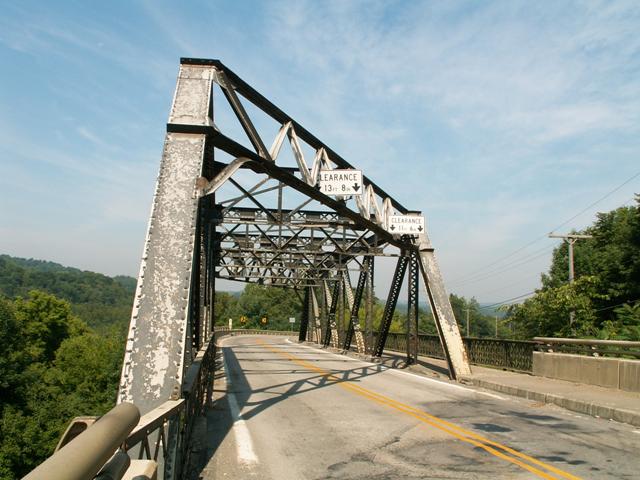We Recommend:
Bach Steel - Experts at historic truss bridge restoration.
BridgeHunter.com Phase 1 is released to the public! - Visit Now
Chewton Bridge

Primary Photographer(s): Nathan Holth and Rick McOmber
Bridge Documented: August 1, 2007
1975
153.0 Feet (46.6 Meters)
319.0 Feet (97.2 Meters)
23.3 Feet (7.1 Meters)
1 Main Span(s) and 4 Approach Span(s)
370288004000000

View Information About HSR Ratings
Bridge Documentation
This bridge no longer exists!
Bridge Status: This historic bridge has been demolished and replaced!View Archived National Bridge Inventory Report - Has Additional Details and Evaluation
This six panel structure is interesting because it is a relatively early example of a state standard plan truss in Pennsylvania, because many more survive from the 1930s in the state. The design of this bridge varies from those 1930s structures a bit. One of the most notable unusual details is the pedestrian railings which are a variation of a lattice style. The vehicular lattice railing is more standard and is not the same as the pedestrian railing as the Historic Bridge Inventory claims. The sway bracing is an unusual design, featuring two rows of lattice, with each row having a different size.
The approach spans are not original, however the main truss span is original and it also retains original railings and good historic integrity. As a result, in the process of evaluating the significance and preservation of this bridge, only the main span should be considered.
Information and Findings From Pennsylvania's Historic Bridge InventoryDiscussion of Bridge The skewed, 5 span, 319'-long bridge consists of a riveted, 153' long Pratt thru truss main span built in 1922 and four continuous stringer approach spans placed in 1975 replacing the original T beam approach spans. There are modern safety shape barriers on the approach spans. The truss span is traditionally composed with built up members, and it does not have any innovative or distinctive details. The cantilevered sidewalk on the truss span is finished with a lattice railing, and the same railing is inside the opposite truss. The bridge was significantly altered in 1975 when the approach spans were replaced. Its original appearance and associative significance with the B & O have been lost. The truss itself is not significant as it is an example of common period technology. The bridge is not historically or technologically significant. Discussion of Surrounding Area The bridge carries a two-lane road and a sidewalk over two CSXT (formerly the B&O main line) tracks in a sparsely developed area north of the village of Chewton. The line was the B&O's 1870s route to Chicago, which supplanted much of an earlier and more circuitous route, and it played a primary role in making the B&O a major trunk line east of the Mississippi River. Bridge Considered Historic By Survey: No |
![]()
Photo Galleries and Videos: Chewton Bridge
Bridge Photo-Documentation
A collection of overview and detail photos. This photo gallery contains a combination of Original Size photos and Mobile Optimized photos in a touch-friendly popup viewer.Alternatively, Browse Without Using Viewer
![]()
Maps and Links: Chewton Bridge
This historic bridge has been demolished. This map is shown for reference purposes only.
Coordinates (Latitude, Longitude):
Search For Additional Bridge Listings:
Bridgehunter.com: View listed bridges within 0.5 miles (0.8 kilometers) of this bridge.
Bridgehunter.com: View listed bridges within 10 miles (16 kilometers) of this bridge.
Additional Maps:
Google Streetview (If Available)
GeoHack (Additional Links and Coordinates)
Apple Maps (Via DuckDuckGo Search)
Apple Maps (Apple devices only)
Android: Open Location In Your Map or GPS App
Flickr Gallery (Find Nearby Photos)
Wikimedia Commons (Find Nearby Photos)
Directions Via Sygic For Android
Directions Via Sygic For iOS and Android Dolphin Browser
USGS National Map (United States Only)
Historical USGS Topo Maps (United States Only)
Historic Aerials (United States Only)
CalTopo Maps (United States Only)

